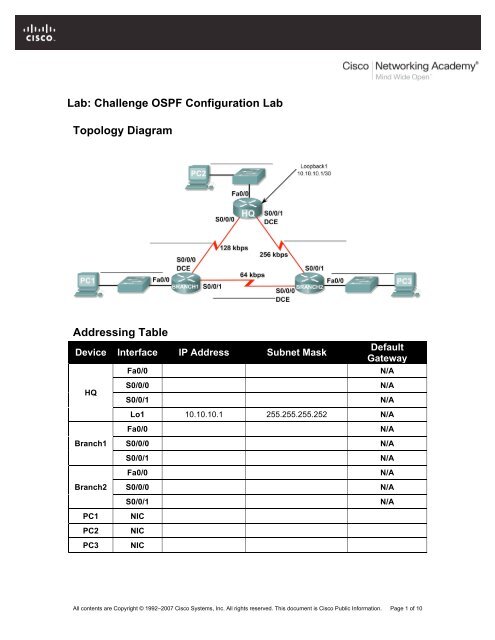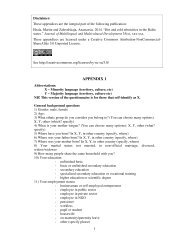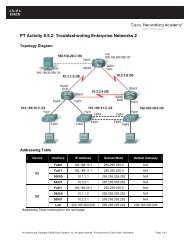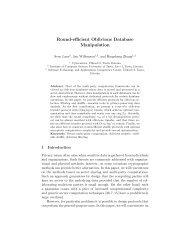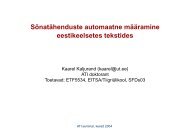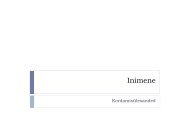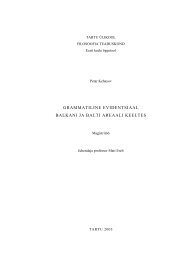Lab: Challenge OSPF Configuration Lab Topology Diagram ...
Lab: Challenge OSPF Configuration Lab Topology Diagram ...
Lab: Challenge OSPF Configuration Lab Topology Diagram ...
Create successful ePaper yourself
Turn your PDF publications into a flip-book with our unique Google optimized e-Paper software.
<strong>Lab</strong>: <strong>Challenge</strong> <strong>OSPF</strong> <strong>Configuration</strong> <strong>Lab</strong><br />
<strong>Topology</strong> <strong>Diagram</strong><br />
Addressing Table<br />
Device Interface IP Address Subnet Mask<br />
HQ<br />
Branch1<br />
Branch2<br />
PC1 NIC<br />
PC2 NIC<br />
PC3 NIC<br />
Default<br />
Gateway<br />
Fa0/0 N/A<br />
S0/0/0 N/A<br />
S0/0/1 N/A<br />
Lo1 10.10.10.1 255.255.255.252 N/A<br />
Fa0/0 N/A<br />
S0/0/0 N/A<br />
S0/0/1 N/A<br />
Fa0/0 N/A<br />
S0/0/0 N/A<br />
S0/0/1 N/A<br />
All contents are Copyright © 1992–2007 Cisco Systems, Inc. All rights reserved. This document is Cisco Public Information. Page 1 of 10
CCNA Exploration<br />
Routing Protocols and Concepts: <strong>OSPF</strong> <strong>Lab</strong>: <strong>Challenge</strong> <strong>OSPF</strong> <strong>Configuration</strong> <strong>Lab</strong><br />
Learning Objectives<br />
Upon completion of this lab, you will be able to:<br />
• Create an efficient VLSM design given requirements<br />
• Assign appropriate addresses to interfaces and document<br />
• Cable a network according to the <strong>Topology</strong> <strong>Diagram</strong><br />
• Erase the startup configuration and reload a router to the default state<br />
• Configure routers including <strong>OSPF</strong><br />
• Configure and propagate a static default route<br />
• Verify <strong>OSPF</strong> operation<br />
• Test and verify full connectivity<br />
• Reflect upon and document the network implementation<br />
Scenario<br />
In this lab activity, you will be given a network address that must be subnetted using VLSM to<br />
complete the addressing of the network shown in the <strong>Topology</strong> <strong>Diagram</strong>. A combination <strong>OSPF</strong><br />
routing and static routing will be required so that hosts on networks that are not directly<br />
connected will be able to communicate with each other. <strong>OSPF</strong> area ID of 0 and process ID of 1<br />
will be used in all <strong>OSPF</strong> configurations.<br />
Task 1: Subnet the Address Space.<br />
Step 1: Examine the network requirements.<br />
The addressing for the Network has the following requirements.<br />
• The 172.20.0.0/16 network must be subnetted to provide addresses for the LANs and<br />
serial links.<br />
o The HQ LAN will require 8000 addresses<br />
o The Branch1 LAN will require 4000 addresses<br />
o The Branch 2 LAN will require 2000 addresses<br />
o The links between the routers will require two addresses for each link<br />
• The loopback address representing the link between the HQ router and the ISP will use<br />
the 10.10.10.0/30 network.<br />
Step 2: Consider the following questions when creating your network design.<br />
How many subnets need to be created from the 172.20.0.0/16 network? ________<br />
How many total IP addresses are required from the 172.16.0.0/16 network? ____________<br />
What subnet mask will be used for the HQ LAN subnet? ________________________<br />
What is the maximum number of host addresses that could be used on this subnet? __________<br />
What subnet mask will be used for the Branch1 LAN subnet? ___________________<br />
What is the maximum number of host addresses that could be used on this subnet? __________<br />
All contents are Copyright © 1992–2007 Cisco Systems, Inc. All rights reserved. This document is Cisco Public Information. Page 2 of 10
CCNA Exploration<br />
Routing Protocols and Concepts: <strong>OSPF</strong> <strong>Lab</strong>: <strong>Challenge</strong> <strong>OSPF</strong> <strong>Configuration</strong> <strong>Lab</strong><br />
What subnet mask will be used for the Branch2 LAN subnet? _____________________<br />
What is the maximum number of host addresses that could be used on this subnet? __________<br />
What subnet mask will be used for the links between the three routers? ____________________<br />
What is the maximum number of host addresses that could be used on each of these subnets?<br />
________<br />
Step 3: Assign subnetwork addresses to the <strong>Topology</strong> <strong>Diagram</strong>.<br />
1. Assign subnet 0 of the 172.20.0.0/16 network to the HQ LAN subnet. What is the network<br />
address of this subnet? _________________<br />
2. Assign subnet 1 of the 172.20.0.0/16 network to the Branch1 LAN subnet. What is the<br />
network address of this subnet? ______________________<br />
3. Assign subnet 2 of the 172.20.0.0/16 network to the Branch2 LAN subnet. What is the<br />
network address of this subnet? ______________________<br />
4. Assign subnet 3 of the 172.20.0.0/16 network to the link between the HQ and Branch1<br />
routers. What is the network address of this subnet? ___________________________<br />
5. Assign subnet 4 of the 172.20.0.0/16 network to the link between the HQ and Branch2<br />
routers. What is the network address of this subnet? ___________________________<br />
6. Assign subnet 5 of the 172.20.0.0/16 network to the link between the Branch1 and<br />
Branch2 routers. What is the network address of this subnet? ____________________<br />
Task 2: Determine Interface Addresses.<br />
Assign appropriate addresses to the device interfaces.<br />
1. Assign the first valid host address in the 10.10.10.0/30 network to the Loopback 1<br />
interface on the HQ router.<br />
2. Assign the first valid IP address of the HQ LAN network to the LAN interface of the HQ<br />
router.<br />
3. Assign the last valid IP address of the HQ LAN network to PC2.<br />
4. Assign the first valid IP address of the Branch1 LAN network to the LAN interface of the<br />
Branch1 router.<br />
5. Assign the last valid IP address of the Branch1 LAN network to PC1.<br />
6. Assign the first valid IP address of the Branch2 LAN network to the LAN interface of the<br />
Branch2 router.<br />
7. Assign the last valid IP address of the Branch2 LAN network to PC3.<br />
All contents are Copyright © 1992–2007 Cisco Systems, Inc. All rights reserved. This document is Cisco Public Information. Page 3 of 10
CCNA Exploration<br />
Routing Protocols and Concepts: <strong>OSPF</strong> <strong>Lab</strong>: <strong>Challenge</strong> <strong>OSPF</strong> <strong>Configuration</strong> <strong>Lab</strong><br />
8. Assign the first valid IP address of the HQ to Branch1 link network to the Serial 0/0/0<br />
interface of the HQ router.<br />
9. Assign the last valid IP address of the HQ to Branch1 link network to the Serial0/0/0<br />
interface of the Branch router.<br />
10. Assign the first valid IP address of the HQ to Branch2 link network to the Serial 0/0/1<br />
interface of the HQ router.<br />
11. Assign the last valid IP address of the HQ to Branch2 link network to the Serial0/0/1<br />
interface of the Branch2 router.<br />
12. Assign the first valid IP address of the Branch1 to Branch2 link network to the Serial 0/0/1<br />
interface of the Branch1 router.<br />
13. Assign the last valid IP address of the Branch1 to Branch2 link network to the Serial0/0/0<br />
interface of the Branch2 router.<br />
Document the addresses to be used in the table provided under the <strong>Topology</strong> <strong>Diagram</strong>.<br />
Task 3: Prepare the Network.<br />
Step 1: Cable a network that is similar to the one in the <strong>Topology</strong> <strong>Diagram</strong>.<br />
You can use any current router in your lab as long as it has the required interfaces as shown in<br />
the topology.<br />
Step 2: Clear any existing configurations on the routers.<br />
Task 4: Perform Basic Router <strong>Configuration</strong>s.<br />
Perform basic configuration of the BRANCH, HQ, and ISP routers according to the following<br />
guidelines:<br />
1. Configure the router hostname.<br />
2. Disable DNS lookup.<br />
3. Configure an EXEC mode password.<br />
4. Configure a message-of-the-day banner.<br />
5. Configure a password for console connections.<br />
6. Configure a password for VTY connections.<br />
7. Synchronize unsolicited messages and debug output with solicited output and prompts<br />
for the console and virtual terminal lines.<br />
8. Configure an EXEC timeout of 15 minutes.<br />
All contents are Copyright © 1992–2007 Cisco Systems, Inc. All rights reserved. This document is Cisco Public Information. Page 4 of 10
CCNA Exploration<br />
Routing Protocols and Concepts: <strong>OSPF</strong> <strong>Lab</strong>: <strong>Challenge</strong> <strong>OSPF</strong> <strong>Configuration</strong> <strong>Lab</strong><br />
Task 5: Configure and Activate Serial and Ethernet Addresses.<br />
Step 1: Configure the interfaces on the HQ, Branch1, and Branch2 routers with the IP<br />
addresses from the table provided under the <strong>Topology</strong> <strong>Diagram</strong>.<br />
When you have finished, be sure to save the running configuration to the NVRAM of the router.<br />
Step 2: Configure the Ethernet interfaces of PC1, PC2, and PC3 with the IP addresses from<br />
the table provided under the <strong>Topology</strong> <strong>Diagram</strong>.<br />
Step 3: Configure the correct bandwidth for the serial interfaces on the Branch 1 router.<br />
What commands are required to accomplish this?<br />
_____________________________________________________________________________<br />
_____________________________________________________________________________<br />
_____________________________________________________________________________<br />
_____________________________________________________________________________<br />
_____________________________________________________________________________<br />
_____________________________________________________________________________<br />
Step 4: Configure the correct bandwidth for the serial interfaces on the Branch 2 router.<br />
What commands are required to accomplish this?<br />
_____________________________________________________________________________<br />
_____________________________________________________________________________<br />
_____________________________________________________________________________<br />
_____________________________________________________________________________<br />
_____________________________________________________________________________<br />
_____________________________________________________________________________<br />
All contents are Copyright © 1992–2007 Cisco Systems, Inc. All rights reserved. This document is Cisco Public Information. Page 5 of 10
CCNA Exploration<br />
Routing Protocols and Concepts: <strong>OSPF</strong> <strong>Lab</strong>: <strong>Challenge</strong> <strong>OSPF</strong> <strong>Configuration</strong> <strong>Lab</strong><br />
Step 5: Configure the correct bandwidth for the serial interfaces on the HQ router.<br />
What commands are required to accomplish this?<br />
_____________________________________________________________________________<br />
_____________________________________________________________________________<br />
_____________________________________________________________________________<br />
_____________________________________________________________________________<br />
_____________________________________________________________________________<br />
_____________________________________________________________________________<br />
Task 6: Verify Connectivity to Next Hop Device.<br />
You should NOT have connectivity between end devices yet. However, you can test connectivity<br />
between two routers and between and end device and its default gateway.<br />
Step 1: Verify that the HQ, Branch1, and Branch2 routers can ping each of the neighboring<br />
routers across the WAN links.<br />
Step 2: Verify that PC1, PC2, and PC3 can ping their respective default gateway.<br />
Task 7: Configure <strong>OSPF</strong> Routing on the Branch1 Router.<br />
Step 1: Consider the networks that need to be included in the <strong>OSPF</strong> updates that are sent<br />
out by the Branch1 router.<br />
What directly connected networks are present in the Branch1 routing table?<br />
_____________________________________________________________________________<br />
_____________________________________________________________________________<br />
_____________________________________________________________________________<br />
What commands are required to enable <strong>OSPF</strong> and include the connected networks in the routing<br />
updates?<br />
_____________________________________________________________________________<br />
_____________________________________________________________________________<br />
_____________________________________________________________________________<br />
_____________________________________________________________________________<br />
_____________________________________________________________________________<br />
All contents are Copyright © 1992–2007 Cisco Systems, Inc. All rights reserved. This document is Cisco Public Information. Page 6 of 10
CCNA Exploration<br />
Routing Protocols and Concepts: <strong>OSPF</strong> <strong>Lab</strong>: <strong>Challenge</strong> <strong>OSPF</strong> <strong>Configuration</strong> <strong>Lab</strong><br />
Are there any router interfaces that do not need to have <strong>OSPF</strong> updates sent out? ____________<br />
What command is used to disable <strong>OSPF</strong> updates on these interfaces?<br />
_____________________________________________________________________________<br />
Task 8: Configure <strong>OSPF</strong> and Static Routing on the HQ Router.<br />
Step 1: Consider the type of static routing that is needed on HQ.<br />
A static default route will need to be configured to send all packets with destination addresses<br />
that are not in the routing table to the loopback address representing the link between the HQ<br />
router and the ISP. What command is needed to accomplish this?<br />
_____________________________________________________________________________<br />
What directly connected networks are present in the HQ routing table?<br />
_____________________________________________________________________________<br />
_____________________________________________________________________________<br />
_____________________________________________________________________________<br />
_____________________________________________________________________________<br />
_____________________________________________________________________________<br />
Will the networks of the HQ LAN and the links between the Branch 1 and Branch2 routers need to<br />
have the subnet mask information included in the network statements? __________<br />
What commands are required to enable <strong>OSPF</strong> and include the appropriate networks in the<br />
routing updates?<br />
_____________________________________________________________________________<br />
_____________________________________________________________________________<br />
_____________________________________________________________________________<br />
_____________________________________________________________________________<br />
_____________________________________________________________________________<br />
_____________________________________________________________________________<br />
Are there any router interfaces that do not need to have <strong>OSPF</strong> updates sent out? ____________<br />
What command is used to disable <strong>OSPF</strong> updates on these interfaces?<br />
_____________________________________________________________________________<br />
_____________________________________________________________________________<br />
All contents are Copyright © 1992–2007 Cisco Systems, Inc. All rights reserved. This document is Cisco Public Information. Page 7 of 10
CCNA Exploration<br />
Routing Protocols and Concepts: <strong>OSPF</strong> <strong>Lab</strong>: <strong>Challenge</strong> <strong>OSPF</strong> <strong>Configuration</strong> <strong>Lab</strong><br />
The HQ router needs to send the default route information to the Branch1 and Branch2 routers in<br />
the <strong>OSPF</strong> updates. What command is used to configure this?<br />
_____________________________________________________________________________<br />
Task 9: Configure <strong>OSPF</strong> Routing on the Branch2 Router.<br />
Step 1: Consider the networks that need to be included in the <strong>OSPF</strong> updates that are sent<br />
out by the Branch2 router.<br />
What directly connected networks are present in the Branch2 routing table?<br />
_____________________________________________________________________________<br />
_____________________________________________________________________________<br />
_____________________________________________________________________________<br />
What commands are required to enable <strong>OSPF</strong> and include the connected networks in the routing<br />
updates?<br />
_____________________________________________________________________________<br />
_____________________________________________________________________________<br />
_____________________________________________________________________________<br />
_____________________________________________________________________________<br />
_____________________________________________________________________________<br />
Are there any router interfaces that do not need to have <strong>OSPF</strong> updates sent out? ____________<br />
What command is used to disable <strong>OSPF</strong> updates on these interfaces?<br />
_____________________________________________________________________________<br />
Task 10: Verify the <strong>Configuration</strong>s<br />
Answer the following questions to verify that the network is operating as expected.<br />
From PC1, is it possible to ping PC2? ____________<br />
From PC1, is it possible to ping the PC3? ___________<br />
The answer to the above questions should be ‘yes’. If any of the above pings failed, check your<br />
physical connections and configurations. Refer to your basic troubleshooting techniques used in<br />
the [Chapter 1] labs.<br />
All contents are Copyright © 1992–2007 Cisco Systems, Inc. All rights reserved. This document is Cisco Public Information. Page 8 of 10
CCNA Exploration<br />
Routing Protocols and Concepts: <strong>OSPF</strong> <strong>Lab</strong>: <strong>Challenge</strong> <strong>OSPF</strong> <strong>Configuration</strong> <strong>Lab</strong><br />
What <strong>OSPF</strong> routes are present in the routing table of the Branch1 router?<br />
_____________________________________________________________________________<br />
_____________________________________________________________________________<br />
_____________________________________________________________________________<br />
_____________________________________________________________________________<br />
_____________________________________________________________________________<br />
What is the gateway of last resort in the routing table of the Branch1 router?<br />
_____________________________________________________________________________<br />
What <strong>OSPF</strong> routes are present in the routing table of the HQ router?<br />
_____________________________________________________________________________<br />
_____________________________________________________________________________<br />
_____________________________________________________________________________<br />
_____________________________________________________________________________<br />
_____________________________________________________________________________<br />
What is the gateway of last resort in the routing table of the HQ router?<br />
_____________________________________________________________________________<br />
What <strong>OSPF</strong> routes are present in the routing table of the Branch2 router?<br />
_____________________________________________________________________________<br />
_____________________________________________________________________________<br />
_____________________________________________________________________________<br />
_____________________________________________________________________________<br />
_____________________________________________________________________________<br />
What is the gateway of last resort in the routing table of the Branch2 router?<br />
_____________________________________________________________________________<br />
All contents are Copyright © 1992–2007 Cisco Systems, Inc. All rights reserved. This document is Cisco Public Information. Page 9 of 10
CCNA Exploration<br />
Routing Protocols and Concepts: <strong>OSPF</strong> <strong>Lab</strong>: <strong>Challenge</strong> <strong>OSPF</strong> <strong>Configuration</strong> <strong>Lab</strong><br />
Task 11: Reflection<br />
On PC1, use the tracert command to examine the route that is used between PC1 and PC3.<br />
What are the hops in the route to PC3?<br />
_____________________________________________________________________________<br />
_____________________________________________________________________________<br />
_____________________________________________________________________________<br />
_____________________________________________________________________________<br />
Is this the least number of hops that can be used to reach PC3? ____________<br />
If the answer is no, why is a path with more than the minimum amount of hops used?<br />
_____________________________________________________________________________<br />
_____________________________________________________________________________<br />
_____________________________________________________________________________<br />
_____________________________________________________________________________<br />
_____________________________________________________________________________<br />
_____________________________________________________________________________<br />
Task 12: Clean Up<br />
Erase the configurations<br />
• erase startup-config<br />
Disconnect and store the cabling. For PC hosts that are normally connected to other networks<br />
(such as the school LAN or to the Internet), reconnect the appropriate cabling and restore the<br />
TCP/IP settings.<br />
All contents are Copyright © 1992–2007 Cisco Systems, Inc. All rights reserved. This document is Cisco Public Information. Page 10 of 10


